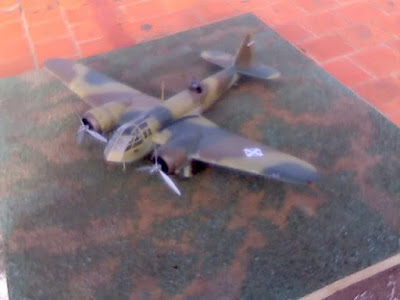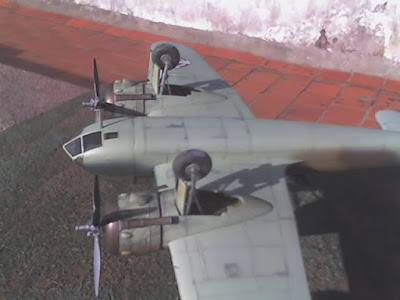Bristol (Ikarus) Blenheim Mk.I
When you talk about the Bristol Blenheim Mk.I/IV with other modelers, all that is remembered are images of the airplane falling in flames from the sky, whiped out by enemy fighters all over the continents in which W.W.II was carried on. And that image is quite correct. As a pre-war light bomber from 1937, armed with a couple of rifle caliber machine guns and a top speed that by 1940 was rather mediocre, it had virtually no defence against fighters, specially those armed with cannons. Not even the fighter versions, fitted with special gun packs in their bellies were out of harm's way. But, it was solidly built, pleasant to fly and always there when needed. That is, until it came to be quite obvious that the development of bombing tactics was moving on to more powerful, capable airplanes. From that moment on, more and more Blenheims were used for training crews and by 1944 it had been officially retired from active service in the U.K. Last, but not least, it has always had a place in my heart, as a true underdog deserves. Several versions, in service with many countries. Stories of war and peace, mostly on the losing side. Simply irresistible to me.
One of those stories centers on Yugoslavia's Vazduhoplovstvo Vojno (Air Arm) use of the Bristol Blenheim in light bombing duties during the short war against Germany in the Spring of 1941, serving in the 1st and 8th Bombing Regiments and the 11th Independent Group. Despite the bitter conditions of the campaign and with some of them destroyed on the ground by the Luftwaffe, the Blenheims and their crews carried on a valiant array of duties such as bombing armour and infantry columns in a close support role and just a few, very brave and dangerous raids against targets as far as Hungary, Austria and the bulgarian border from where the germans launched their offensive.
When you talk about the Bristol Blenheim Mk.I/IV with other modelers, all that is remembered are images of the airplane falling in flames from the sky, whiped out by enemy fighters all over the continents in which W.W.II was carried on. And that image is quite correct. As a pre-war light bomber from 1937, armed with a couple of rifle caliber machine guns and a top speed that by 1940 was rather mediocre, it had virtually no defence against fighters, specially those armed with cannons. Not even the fighter versions, fitted with special gun packs in their bellies were out of harm's way. But, it was solidly built, pleasant to fly and always there when needed. That is, until it came to be quite obvious that the development of bombing tactics was moving on to more powerful, capable airplanes. From that moment on, more and more Blenheims were used for training crews and by 1944 it had been officially retired from active service in the U.K. Last, but not least, it has always had a place in my heart, as a true underdog deserves. Several versions, in service with many countries. Stories of war and peace, mostly on the losing side. Simply irresistible to me.
One of those stories centers on Yugoslavia's Vazduhoplovstvo Vojno (Air Arm) use of the Bristol Blenheim in light bombing duties during the short war against Germany in the Spring of 1941, serving in the 1st and 8th Bombing Regiments and the 11th Independent Group. Despite the bitter conditions of the campaign and with some of them destroyed on the ground by the Luftwaffe, the Blenheims and their crews carried on a valiant array of duties such as bombing armour and infantry columns in a close support role and just a few, very brave and dangerous raids against targets as far as Hungary, Austria and the bulgarian border from where the germans launched their offensive.
The first Blenheims to reach Yugoslavia were L160 and 161 (pattern machines numbers 8814 and 8815) in 1938. The first Ikarus built machine flew in March, 1939 followed by another 15 of the type. So Yugoslavia became the second country to license produce the Blenheim, after Finland's State Aircraft Factory. The british Royal Air Force transfered 20 Blenheims to the V.V. from its stocks in early 1940.
At the time of surrender, a total of 24 Blenheims were in various degrees of completion at Ikarus plant located in the town of Zemun. Yugoslav partisans sabotaged the production lines, thus preventing the use of the airframes by the germans. The few examples that survived the Blitz were transfered after overhauling to the newly created Croatian Air Force, wich used them for anti-partisan duties.
The kit - Bristol Blenheim Mk.I, MPM 1/72
The kit - Bristol Blenheim Mk.I, MPM 1/72
MPM released their Blenheim series some years ago and while you don't see them very often, they're quite fun to work and a remarkable option to Airfix and Frog's respectfuly old offerings. The one presented here was built in 2006 and is one of the options given in MPM's nice decal sheet, along with a pre-war british and a 1942 finnish examples. Specially the Ksovsky Krist's (Cross of Kosovo, the yugoslavian A.F. insignia) is a lovely rendition of the originial. The plastic is soft but very workable, the resin and photoetched parts are first rate. Wether you build this kit from the box or adding some extra detail to beef it up, you'll get an excellent rendition of this classic bomber.
The only additions were a scratchbuilt seat for the gunner, a couple of levers in the cockpit and the scratch-built Darne 7.92mm machine gun in the Bristol B.I turret. This gun was used sometimes instead of the Browning FN. The landing lights were also scratch built, but I failed to make a convincing replica of the curved plastic cover. After many failed attempts, I just had to let it be.
The only additions were a scratchbuilt seat for the gunner, a couple of levers in the cockpit and the scratch-built Darne 7.92mm machine gun in the Bristol B.I turret. This gun was used sometimes instead of the Browning FN. The landing lights were also scratch built, but I failed to make a convincing replica of the curved plastic cover. After many failed attempts, I just had to let it be.
Paints were ModelMaster's RAF Dark Earth, RAF Stone and RLM 80 for the uppers and MM's RAF Sky for the undersides. The RLM color was used for it gave me a better impresion about the Olive Green used in these airplanes than the commonplace RAF Dark Green.
Some weathering was given to the plane such as oil stains and paint flaking with black washes and some Humbrol 191. You have to remember these planes were well mantained and kept clean until the war broke out, so focus only on "operational areas" such as the upperside of the fuselage, bomb bay and landing gears, leading edges, etc, etc.
And there you have it, a Yugoslavian Blenheim... If MPM would just release the Mk.I again, with decals for the other operators of this aircraft (Turkey, Romania, Croatia, etc.) we'd certainly appreciate it!
Final, "professional " photos:
Thanks go to the great Srecko Bradic for maintaining his superb site Letletlet Warplanes on yugoslav and general aviation. The Forums there are teeming with great people!
Till our next installment, take care and good luck,
The Modeling Underdog.










Comments